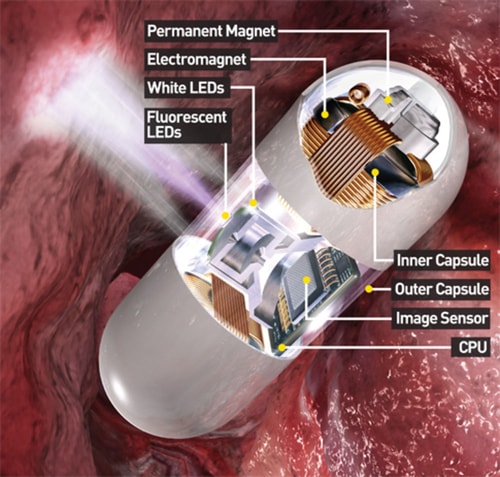Camera capsules are a less invasive diagnostic imaging option
Orange County, CA - July 27th 2016 - Undergoing an endoscopy has an array of benefits, but the nature of the procedure is uncomfortable, even with anesthesia. During this procedure, a flexible tube fixed with a light and camera at the end is passed through the mouth or rectum and pumped with air to allow a physician access to the gastrointestinal tract.
However, alternative methods have emerged to replace the imaging technique – one such approach is called capsule endoscopy, characterized by a fixed camera enveloped within a vitamin sized pill. Commonly used to identify and diagnose diseases in hard to see areas in the body, the system consists of a disposable camera pill, a data recorder, and computer software for analysis.
The simple process consists of fasting for a sustained period of time prior to ingesting the camera capsule. Upon settling in the gastrointestinal tract, the camera begins to capture images in a process spanning roughly eight hours. The capsule moves through the body with the aid of a magnetized vest that has the capacity to wirelessly receive and store images from the pill cam. Upon completing the procedure, computer processing software analyzes the recordings. The pill works its way through the patient’s system within 24-48 hours.

Originally developed in the mid-1990s, the use of this type of device was first approved by the Federal Drug Administration (FDA) in 2001 and became first line in small bowel imaging modality in 2003. Since its introduction to the medical industry 15 years ago, companies such as RF System Lab have emerged at the forefront of the capsule camera sector with the unveiling of their Next Generation Capsule Endoscope, Sayaka.
Whereas most pill cams are fixed with a single front-facing camera, the Sayaka differs in its rotating camera that provides for 360 degree imaging. Although this company’s version of the capsule is awaiting approval by the FDA, the capsule camera can revolve and capture approximately 870,000 two megapixel images at 30 frames per second as it traverses the intestinal tract.
Once the captured images are transferred to the corresponding computer software, built-in tools allow for manipulation such as scaling, measuring, and density assessment. The images can also be compiled into a flat map for simplified viewing.
The capsule requires 50 milliwatts to power the camera and lights housed within it. To provide for this demand, the researchers engineered the magnetized vest to transmit power to the pill with a coil through a process called induction charging.
While the capsule offers a painless way to diagnose gastrointestinal ailments such as Crohn’s or celiac disease, it does not provide a mechanism for treatment options as traditional endoscopy does. However, with the capsule camera’s smart design and relatively low price point, it is a great method for preliminary gastrointestinal diagnostic examination.
Contact Ampronix:

Email: info@ampronix.com
International Sales: +1 949-273-8000
Domestic Sales: 1800-400-7972 for US and Canada
Follow Us:
Share This Article:
View our Product Catalog Online Here
About Ampronix
Ampronix is a renowned authorized master distributor of the medical industry's top brands as well as a world-class manufacturer of innovative technology. Since 1982, Ampronix has been dedicated to meeting the growing needs of the medical community with its extensive product knowledge, outstanding service, and state-of-the-art repair facility. Ampronix prides itself on its ability to offer tailored, one-stop solutions at a faster and more cost-effective rate than other manufacturers. Ampronix is an ISO & ANSI/ESD certified facility. To learn more go here.

Camera capsules are a less invasive diagnostic imaging option Orange County, CA – July 27th 2016 – Undergoing an endoscopy has an array of benefits, but the nature of the procedure is uncomfortable, even with anesthesia. During this procedure, a flexible tube fixed with a light and camera at the end is passed through the mouth or […]



